实验4
试验任务1
程序源码
task1_1.C
#include <stdio.h> #define N 4 int main() { int a[N] = {2, 0, 2, 3}; char b[N] = {'2', '0', '2', '3'}; int i; printf("sizeof(int) = %d\n", sizeof(int)); printf("sizeof(char) = %d\n", sizeof(char)); printf("\n"); // 输出int型数组a中每个元素的地址、值 for (i = 0; i < N; ++i) printf("%p: %d\n", &a[i], a[i]); printf("\n"); // 输出char型数组b中每个元素的地址、值 for (i = 0; i < N; ++i) printf("%p: %c\n", &b[i], b[i]); printf("\n"); // 输出数组名a和b对应的值 printf("a = %p\n", a); printf("b = %p\n", b); return 0; }
运行截图
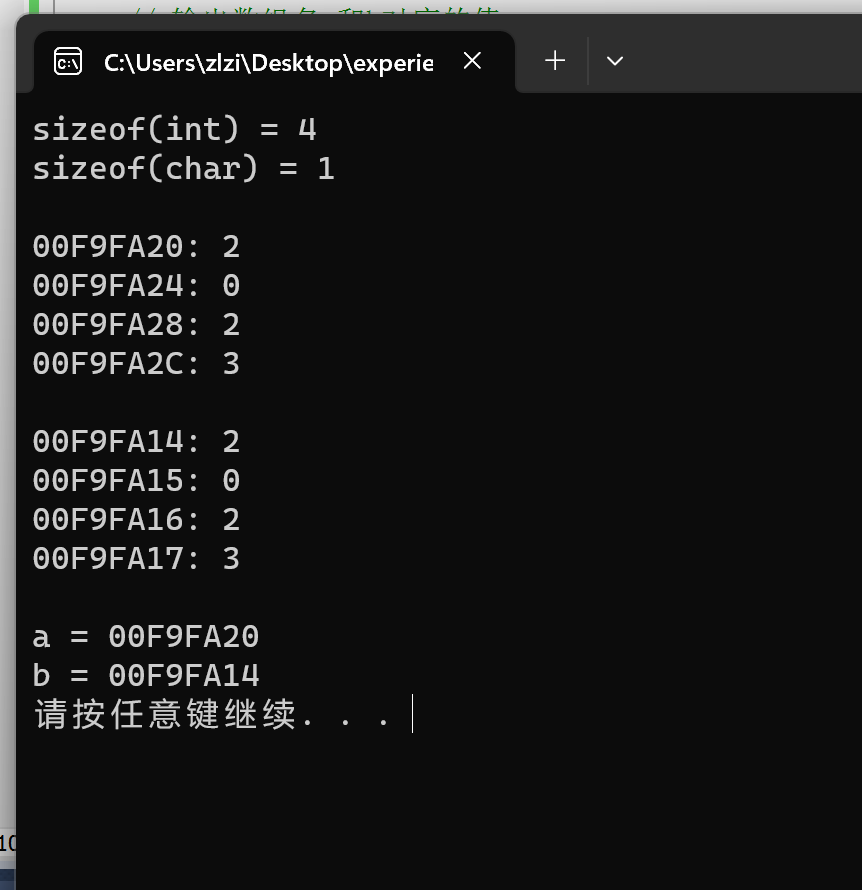
回答问题:
1、int型数组a是在内存中连续存放的,四个字节
2、char型数组b是在内存中连续存放的,一个字节
3、一样的、一样的
task1_2.c
程序源码
#include<stdio.h> #include<stdlib.h> #define N 2 #define M 3 int main(){ int a[N][M] = {{1,2,3},{4,5,6}}; char b[N][M] = {{'1','2','3'},{'4','5','6'}}; int i, j; //输出int型二维数组a中每个元素的地址值 for(i = 0; i<N;++i) for(j = 0; j < M; ++j) printf("%p: %d\n",&a[i][j],a[i][j]); printf("\n"); //输出int型二维数组名a,以及a[0],a[1]的值 printf("a = %p\n",a); printf("a[0] = %p\n",a[0]); printf("a[1] = %p\n",a[1]); printf("\n"); //输出char型二维数组b中每个元素的地址值 for(i=0;i<N;++i) for(j = 0; j<M;++j) printf("%p:%c\n",&b[i][j],b[i][j]); printf("\n"); //输出char型二维数组名,以及b[0],b[1]的值 printf("b = %p\n", b); printf("b[0] = %p\n",b[0]); printf("b[0] = %p\n",&b[0]); printf("b[1] = %p\n",b[1]); printf("b[1] = %p\n",&b[1]); printf("\n"); system("pause"); return 0; }
运行截图
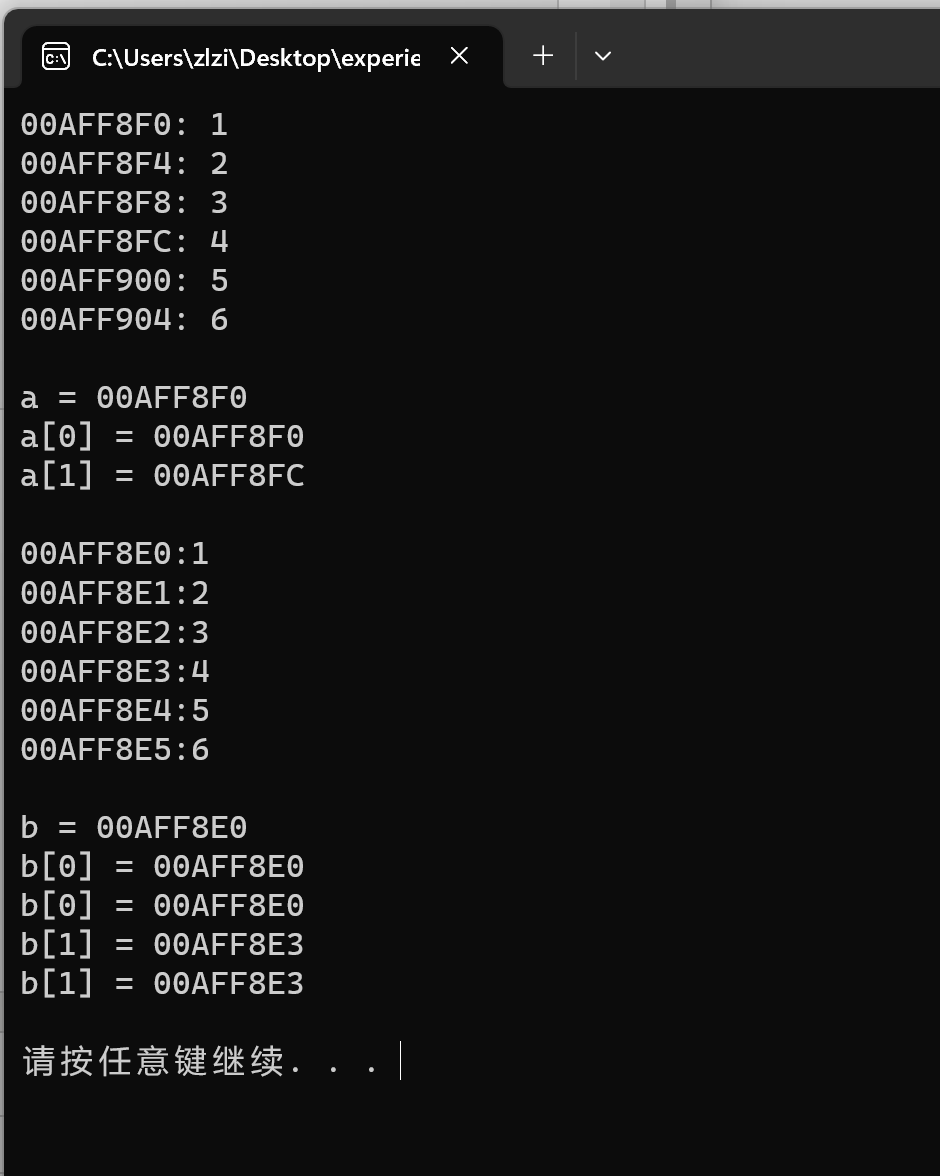
回答问题
1、int型二维数组a是按行连续存放的,四个字节
2、一样的
3、char型二维数组b是按行连续存放的,一个字节
4、一样的
5、a[0]一行有三个元素 一个元素占四个字节,因而a[0]a[1]差12个字节
b[0]一行有三个元素 一个元素占一个字节,因而b[0]b[1]差3个字节
试验任务2
程序源码
task2.c
#include<stdio.h> #include<string.h> #include<stdlib.h> #define N 80 void swap_str(char s1[N],char s2[N]); void test1(); void test2(); int main(){ printf("测试1:用两个一维数组,实现两个字符串交换\n"); test1(); printf("\n测试:用二维数组,实现两个字符串交换\n"); test2(); system("pause"); return 0; } void test1(){ char views1[N] = "hey, C, I hate u."; char views2[N] = "hey, C, I love u."; printf("交换前:\n"); puts(views1); puts(views2); swap_str(views1,views2); printf("交换后: \n"); puts(views1); puts(views2); } void test2(){ char views[2][N] = {"hey, C, I hate u.","hey, C, I love u."}; printf("交换前:\n"); puts(views[0]); puts(views[1]); swap_str(views[0],views[1]); printf("交换后:\n"); puts(views[0]); puts(views[1]);} void swap_str(char s1[N], char s2[N]){ char tmp[N]; strcpy(tmp,s1); strcpy(s1, s2); strcpy(s2,tmp); }
运行截图
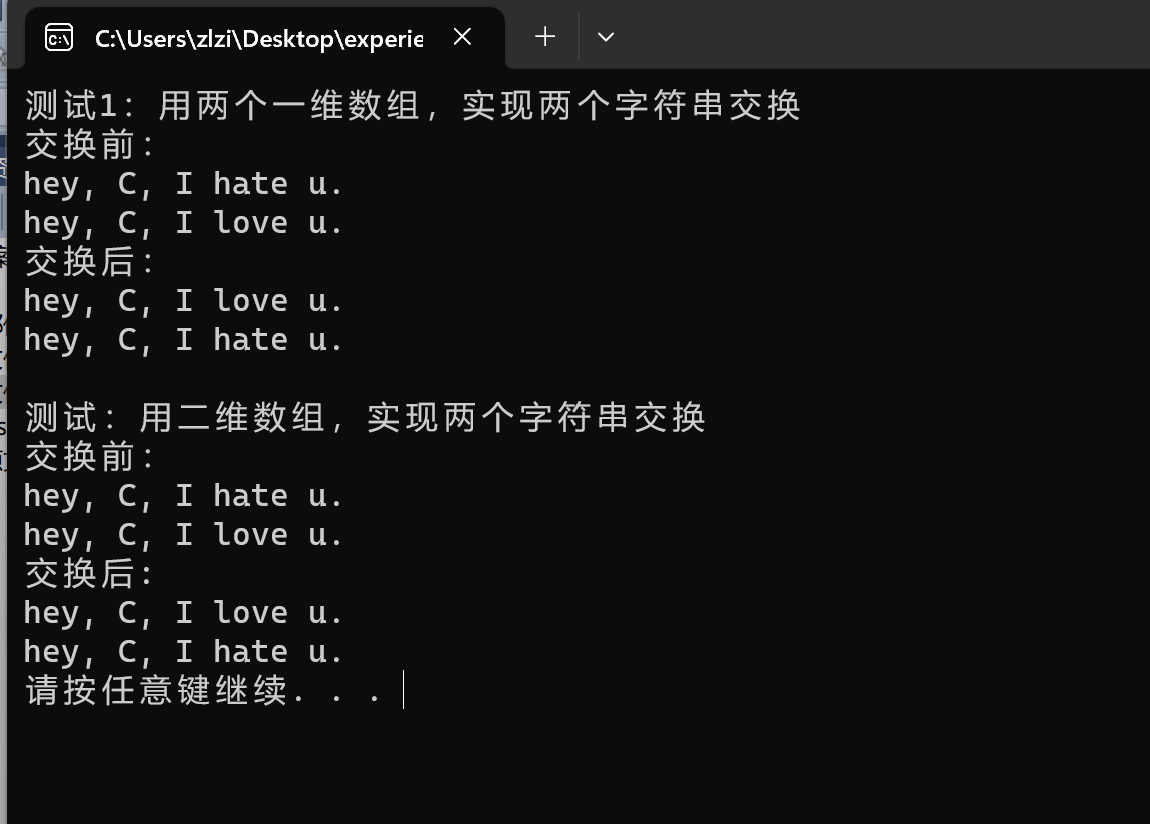
思考思考思考
二维数组加"[]"表示起始元素的地址,可实现数组内容的交换
试验任务3
task3_1.c
#include <stdio.h> #define N 80 int count(char x[]); int main() { char words[N+1]; int n; while(gets(words) != NULL) { n = count(words); printf("单词数: %d\n\n", n); } return 0; } int count(char x[]) { int i; int word_flag = 0; // 用作单词标志,一个新单词开始,值为1;单词结束,值为0 int number = 0; // 统计单词个数 for(i = 0; x[i] != '\0'; i++) { if(x[i] == ' ') word_flag = 0; else if(word_flag == 0) { word_flag = 1; number++; } } return number; }
运行截图
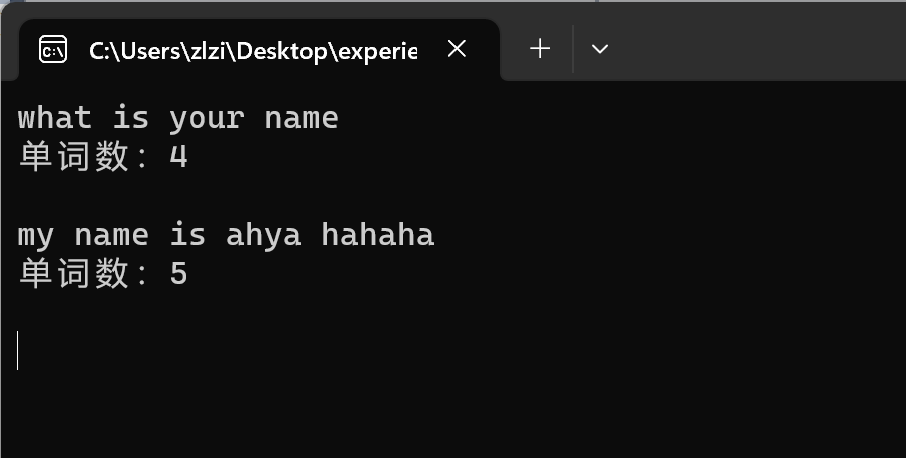
task3_2.c
#include <stdio.h> #define N 1000 int main() { char line[N]; int word_len; // 记录当前单词长度 int max_len; // 记录最长单词长度 int end; // 记录最长单词结束位置 int i; while(gets(line) != NULL) { word_len = 0; max_len = 0; end = 0; i = 0; while(1) { // 跳过连续空格 while(line[i] == ' ') { word_len = 0; // 单词长度置0,为新单词统计做准备(重置) i++; } // 在一个单词中,统计当前单词长度 while(line[i] != '\0' && line[i] != ' ') { word_len++; i++; } // 更新更长单词长度,并,记录最长单词结束位置 if(max_len < word_len) { max_len = word_len; end = i; // end保存的是单词结束的下一个坐标位置 } // 遍历到文本结束时,终止循环 if(line[i] == '\0') break; } // 输出最长单词 printf("最长单词: "); for(i = end - max_len; i < end; ++i) printf("%c", line[i]); printf("\n\n"); } return 0; }
运行截图

实验任务4
#include<stdio.h> #include<stdlib.h> #include<math.h> #define N 5 //函数声明 void input(int x[], int n); void output(int x[],int n); double average(int x[], int n); void bubble_sort(int x[], int n); int main(){ int scores[N]; double ave; printf("录入%d个分数:\n", N); input(scores, N); printf("\n输出课程分数:\n"); output(scores, N); printf("\n课程分数处理:计算均分、排序...\n"); ave = average(scores, N); bubble_sort(scores, N); printf("\n输出课程均分:%.2f\n", ave); printf("\n输出课程分数(高->低):\n"); output(scores, N); system("pause"); return 0; } //函数定义 //输入n个整数保存到整型数组x中 void input(int x[], int n){ int i; for(i = 0; i < n; ++i) scanf("%d",&x[i]); } //输出整型数组x中n个元素 void output(int x[], int n){ int i; for(i = 0; i < n; ++i) printf("%d ",x[i]); printf("\n"); } //计算整型数组x中n个元素均值,并返回 //补足函数average()实现 //xxx double average(int x[], int n){ int i; double ave,s=0; for(i=0;i<n;++i) s+=x[i]; ave=s/(n); return ave; } //对整型数组x中的n个元素均值,并返回 //不足函数bubble_sort()实现 //xxx void bubble_sort(int x[], int n){ int i,j,t; for(i = 0; i < n-1;i++) for(j = 0; j < n-1-i; j++) if(x[j+1]>x[j]){ t=x[j+1]; x[j+1] = x[j]; x[j]=t; } }
运行截图
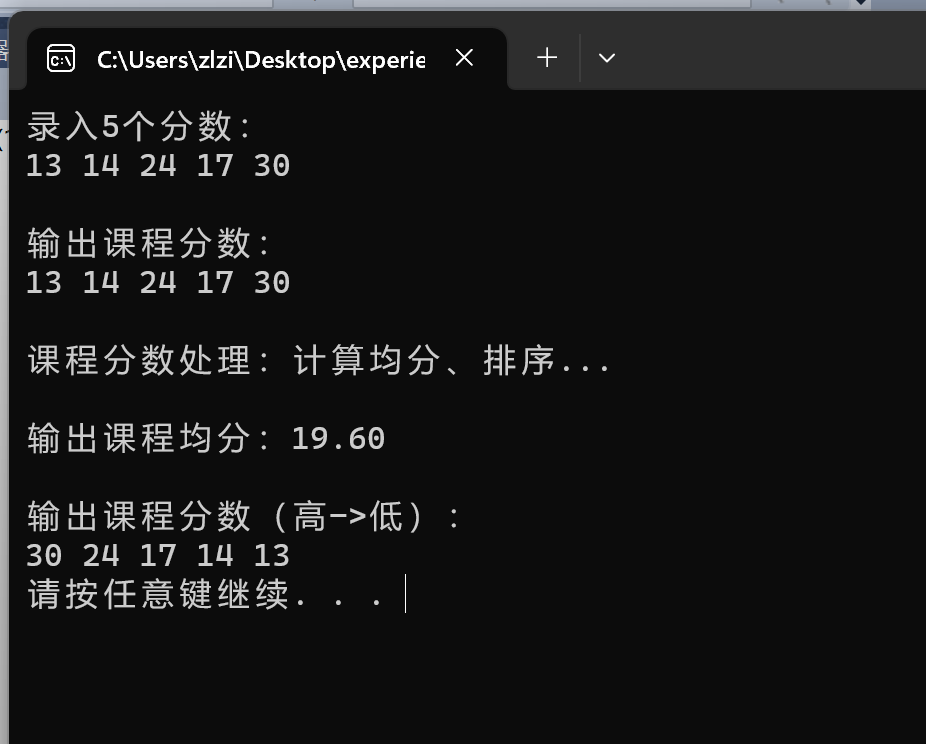
实验任务5
task5.c
#include <stdio.h> #include<stdlib.h> #define N 100 void dec2n(int x, int n); // 函数声明 int main() { int x; printf("输入一个十进制整数: "); while(scanf("%d", &x) != EOF) { dec2n(x, 2); // 函数调用: 把x转换成二进制输出 dec2n(x, 8); // 函数调用: 把x转换成八进制输出 dec2n(x, 16); // 函数调用: 把x转换成十六进制输出 printf("\n输入一个十进制整数: "); } system("pause"); return 0; } // 函数定义 // 功能: 把十进制数x转换成n进制,打印输出 // 补足函数实现 // ××× void dec2n(int x, int n){ int yushu, i=0, t; char a[]={'0','1','2','3','4','5','6','7','8','9','A','B','C','D','E','F'}; char b[N]; while(x!=0) { yushu=x%n; x=x/n; b[i]=a[yushu]; i++; } t=i; for(i=t-1;i>=0;i--) printf("%c",b[i]); printf("\n"); }
运行截图
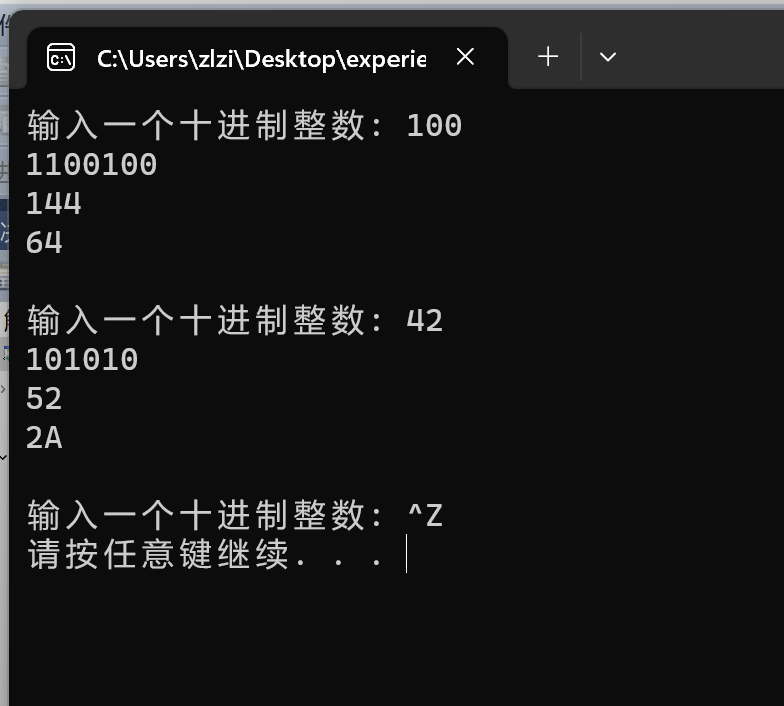
呜呼呜呼呜呼
实验任务6
task6.c
#include <stdio.h> #include<stdlib.h> #define N 100 #define M 4 void output(int x[][N], int n); // 函数声明 void rotate_to_right(int x[][N], int n); // 函数声明 int main() { int t[][N] = {{21, 12, 13, 24}, {25, 16, 47, 38}, {29, 11, 32, 54}, {42, 21, 33, 10}}; printf("原始矩阵:\n"); output(t, M); // 函数调用 rotate_to_right(t, M); // 函数调用 printf("变换后矩阵:\n"); output(t, M); // 函数调用 system("pause"); return 0; } // 函数定义 // 功能: 输出一个n*n的矩阵x void output(int x[][N], int n) { int i, j; for (i = 0; i < n; ++i) { for (j = 0; j < n; ++j) printf("%4d", x[i][j]); printf("\n"); } } // 待补足3:函数rotate_to_right()定义 // 功能: 把一个n*n的矩阵x,每一列向右移, 最右边被移出去的一列绕回左边 // xxx void rotate_to_right(int x[][N], int n){ int i, j, temp; for(i=0;i<n;i++){ temp=x[i][n-1]; for(j=n-1;j>0;j--) { x[i][j]=x[i][j-1];} x[i][0]=temp; } }
运行截图
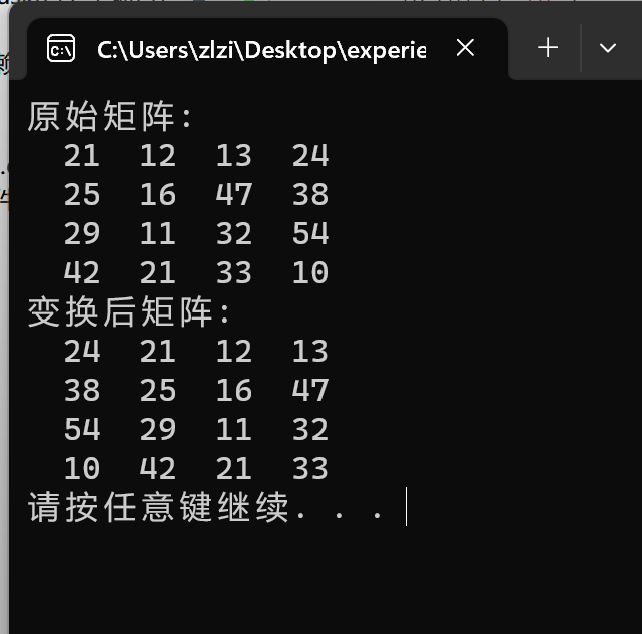
实验任务7
task7_1.c
#include<stdio.h> #define N 80 void replace(char x[],char old_char,char new_char); int main() { char text[N] = "C programming is difficult or not, it is a question."; printf("原始文本:\n"); printf("%s\n",text); replace(text,'i','*'); printf("处理后文本:\n"); printf("%s\n",text); return 0; } void replace(char x[],char old_char,char new_char) { int i; for(i=0;x[i]!='\0';++i) if(x[i]==old_char) x[i] = new_char; }
运行截图

replace90是将所有old_char替换为new_char
'\0'表示字符数组的结束
task7_2.c
#include<stdio.h> #include<stdlib.h> #define N 80 int main(){ char str[N], ch; int i; printf("输入字符串:"); gets(str); printf("输入一个字符:"); ch = getchar(); printf("截断处理......"); i = 0; while(str[i] !='\0'){ if(str[i] == ch){ break;} else i=i++; } str[i] = '\0'; printf("\n截断处理后字符串:%s\n",str); system("pause"); return 0; }
运行截图
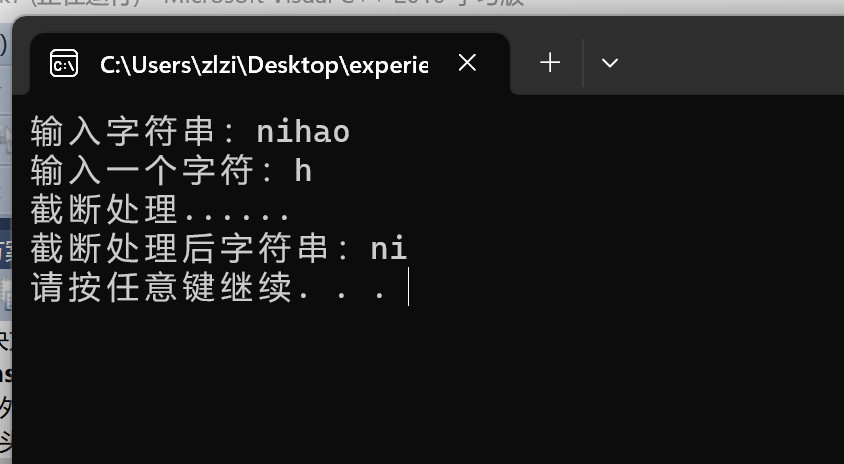
实验任务8
task8.c
#include <stdio.h> #include<stdlib.h> #include <string.h> #define N 5 #define M 20 void bubble_sort(char str[][M], int n); // 函数声明 int main() { char name[][M] = {"Bob", "Bill", "Joseph", "Taylor", "George"}; int i; printf("输出初始名单:\n"); for (i = 0; i < N; i++) printf("%s\n", name[i]); printf("\n排序中...\n"); bubble_sort(name, N); // 函数调用 printf("\n按字典序输出名单:\n"); for (i = 0; i < N; i++) printf("%s\n", name[i]); system("pause"); return 0; } // 函数定义 // 功能:使用冒泡排序算法对二维数组str中的n个字符串按字典序排序 // 补足函数bubble_sort()实现 // ××× void bubble_sort(char str[][M], int n) { int i, j; char t[M]; for(i=0;i<n-1;i++) for(j=0;j<n-1-i;j++) if(strcmp(str[j],str[j+1])>0) { strcpy(t,str[j]); strcpy(str[j],str[j+1]); strcpy(str[j+1],t); } }
运行截图

over


 浙公网安备 33010602011771号
浙公网安备 33010602011771号